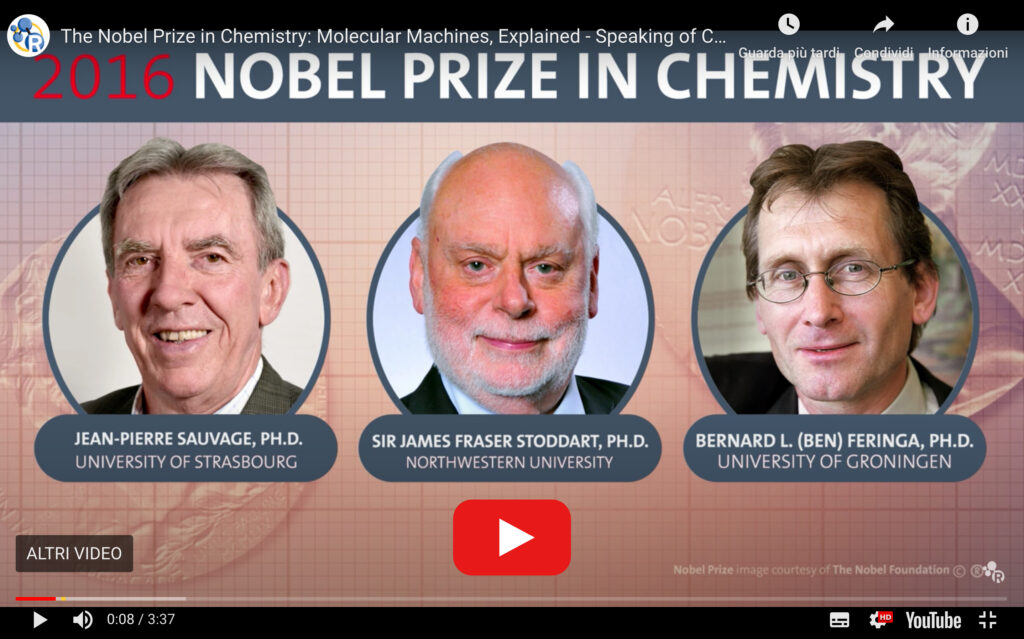3. ARTIFICIAL MOLECULAR MACHINES
From Feynman’s joke to the Nobel Prize in Chemistry
The idea of creating artificial molecular machines was first theorized by Richard Feynman, Nobel Laureate in Physics, in the famous lecture There’s plenty of room at the bottom held on December 29, 1959 at a meeting of the American Physical Society. In the conference, which many consider to be the founding manifesto of nano-technology, Feynman asks in an almost joking manner: «What are the possibilities of small but movable machines? They may or may not be useful, but they surely would be fun to make» (Feynman 1960)1Feynman, R. P. (1960) There’s plenty of room at the bottom, Engineering and Science, 23: 22-36.. Feynman cites the possibility that ultra-miniaturized mechanical devices could be injected into a patient to diagnose or even repair malformations to internal organs. This idea would be resumed a few years later (1966) in the film Fantastic Voyage, from the novel by Isaac Asimov. In short, during the 1960s the construction of nanometric machines, albeit a scientifically valid idea, appears to be a topic closer to science fiction than to science. Be careful, though: history has shown on various occasions that today’s science fiction can become the reality of tomorrow.
In order to further develop the discussion initiated by Feynman, it was necessary to wait until the 1980s, when another physicist, Eric Drexler, proposed the possibility of constructing a nanometer-sized robot capable of manufacturing anything – including replicas of itself – using as a raw material the individual atoms (the so-called universal assembler) (Drexler 1986)2Drexler, K. E. (1986) Engines of creation: the coming era of nanotechnology, New York: Anchor books.. In his 1959 lecture Feynman also noted that «The principles of physics, as far as I can see, do not speak against the possibility of maneuvering things atom by atom» (Feynman 1960). This idea, however, has never been realized and, according to chemists, it is not even feasible. They know very well that atoms are highly reactive species and that, therefore, they cannot be taken from one material and carried to another, as if they were simple Lego blocks. Even the eventual robotic arm, in fact, would be made of atoms, which would end up reacting with the atoms that it would like to manipulate. Feynman himself acknowledges:
Ultimately, we can do chemical synthesis. […] The chemist does a mysterious thing when he wants to make a molecule. […] And, at the end of a difficult process, he usually does succeed in synthesizing what he wants. By the time I get my devices working, so that we can do it by physics, he will have figured out how to synthesize absolutely anything, so that this will really be useless (Feynman 1960).
The universal assembler seems therefore destined to remain an ob-ject of fantasy, the protagonist of stories such as the exhilarating Order of the Cheap by Primo Levi (Levi 1966)3Levi, P. (1966) The sixth day and other tales, New York: Summit Books. Original edition in Italian: Levi, P. (1966) Storie naturali, Torino: Einaudi. or the disturbing Prey by Michael Crichton (Crichton 2002)4Crichton, M. (2003) Prey, New York: HarperCollins..
In the last twenty years chemists have been able to obtain devices and machines at the nanometric level, starting from programmed molecules and following the criteria of supramolecular chemistry (Balzani 2000; Browne 2006; Balzani 2008; Erbas-Cakmak 2015). Although it is not possible to imitate in detail what happens in nature, where molecular machines of incredible complexity are formed spontaneously by self-assembly of programmed molecules, with the chemical bottom-up approach (Fig. 7 and Fig. 8) it has been possible to build quite sophisticated artificial molecular machines and motors. The design phase is, of course, very delicate as the following aspects must be foreseen:
- 1) the type of energy to be used to make the machine work;
- 2) the type of movement that the machine must perform;
- 3) the way in which movements can be controlled;
- 4) the signals that highlight the movements themselves;
- 5) the need to operate in a cyclic and repetitive manner;
- 6) the time taken to complete a cycle;
- 7) the function that can derive from the movements performed.
As we have already seen for natural molecular machines, the mechanical motion implies substantial changes and this result can be achieved in artificial systems only if at least one of the molecular components of the machine is involved in a chemical reaction. Thus, one has to provide, in some form, the energy needed (point 1) to activate the chemical reaction at the basis of the movement, which can be (point 2) of various types (for example, rotary or linear), and whose control (point 3) can be performed with antagonist chemical reactions. The signals that report on the operation of the machine (point 4) arise from modification of the properties of the system (for example, color changes) that accompany the movements. The latter, in turn, must involve reversible reactions in order to enable cyclic operation (point 5). The time scale in which a cycle is completed (point 6) can range from picoseconds (10–12 s, or thousandths of a billionth of a second) to hours, depending on the chemical nature of the system. Finally, various functions can in principle be obtained from the work of the machine (point 7), as it will be shown later.
Some of these aspects – namely, those related to machine control, the signals to verify its functioning, the need to establish a cyclic behavior, and the assessment of operation times – are related to problems that chemists are able to deal with good mastery; the aspects concerning energy supply and the directional control of movements are more critical. Nowadays, numerous types of artificial molecular machines are relatively simple to obtain; the frontier of research in this area, as we will see in Chapter IV, has therefore moved towards the study of the problems associated with the exploitation of nanometric movements for technological and medical applications.
Beyond the possible practical uses, many of which are currently only imaginable, research on artificial molecular machines certainly has the merit of having radically changed the relationship between molecules and scientists. In fact, the introduction of an engineering-type mindset has enormously stimulated the ingenuity and creativity of chemists. This has led to the development of new research lines, often of a highly multidisciplinary nature, which in turn have generated new challenges, thus creating that virtuous circle on which scientific progress is based. These are the reasons which led the Royal Swedish Academy of Sciences to award the 2016 Nobel Prize for Chemistry «for the design and synthesis of molecular machines» to Jean-Pierre Sauvage, Fraser Stoddart and Ben Feringa (Fig. 17).

The recognition of these three distinguished scientists and pioneers in the field testifies to the scientific maturity of the idea of molecular machines, which was born almost as a joke in 1959 and subsequently developed and consolidated thanks to the decades-long commitment of many researchers all over the world.



